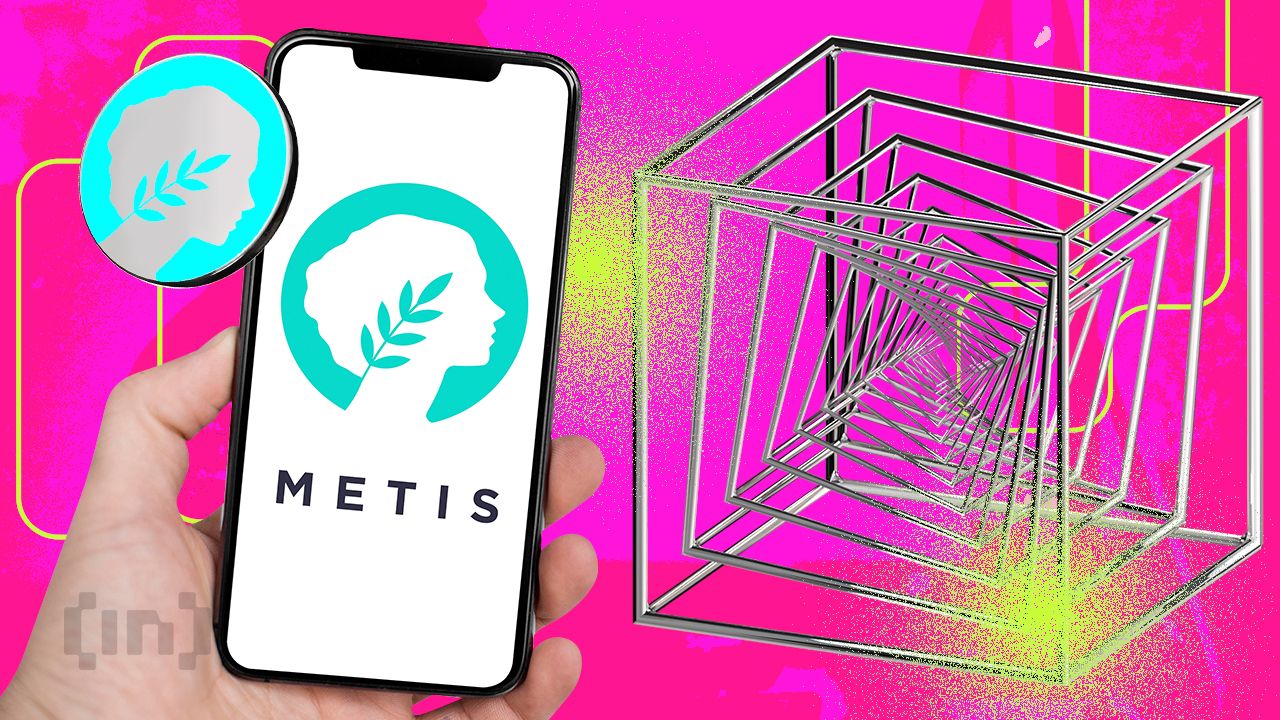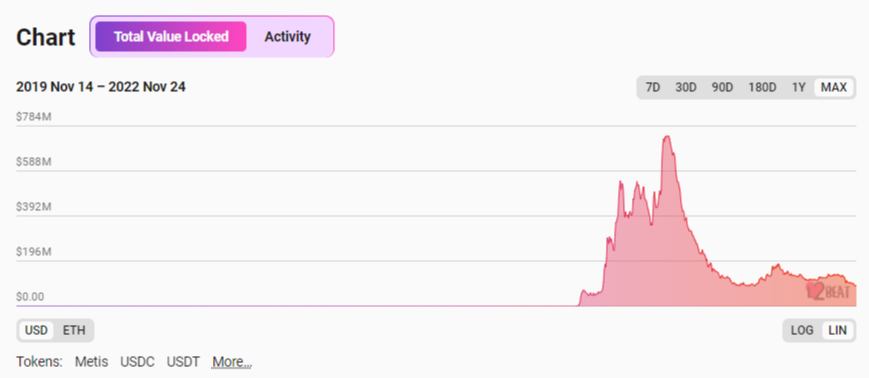An essential part of the Ethereum roadmap is the development of rollups. Rollups are blockchains that make other blockchains more efficient. To put it simply, they move transactions to layer-2 in order to offload some of the pressure of layer-1. Metis crypto protocol is a rollup that aims to solve the challenges of main net Ethereum, such as transaction speed and cost.
The largest problems Ethereum faces, even post-merge, are gas fees and network congestion. Slow transaction processing and high transaction fees can make for a painful web3 experience. Metis offers a variety of products for developers and anyone else seeking solutions to the problems associated with Ethereum.
What is Metis?

As far as layer-2 scaling solutions go, Metis is a general-purpose, optimistic rollup built on Ethereum. This means the Metis protocol can support smart contract development, decentralized applications (DApps), and more scalable transaction processing.
Rollups are attractive because they leverage lower gas fees and faster transaction processing. However, semantic web users want more than faster transactions. Therefore, many layer-2 scaling solutions double as smart contract platforms or virtual machines. The Metis crypto protocol aims to solve the scalability trilemma and simultaneously achieve security, scalability, and decentralization. It also aims to create an affordable and scalable environment for apps, businesses, and the development of the DAO community.
SponsoredAlmost 14,000 unique wallet addresses hold the $METIS token at present. The protocol has facilitated almost 50,000 transactions since its inception.
History
Metis Andromeda — often shortened to just Metis — is an Ethereum layer-2 blockchain created by Metis Labs. The altchain began as a hard fork of Optimism, an Ethereum optimistic rollup.
Metis Labs is a member of Genesi DAC, a venture capitalist decentralized autonomous corporation (DAC) spearheaded by Natalia Ameline — Vitalik Buterin’s mother. The blockchain was founded in 2018; however, the mainnet launched in November 2022. Together with Genesi DAC, Metis Labs released a grant that will financially assist builders on Metis Andromeda.
Founding members
The founding members of Metis Labs may not be star-studded industry vets, but they do bring diverse qualifications. Co-Founder and Product Lead Kevin Liu also co-founded Token Economy Labs Inc. His other qualifications are in finance rather than crypto.
Yuan Siu — technology lead — and CEO Elena Sinelnikova make up the remaining founding members. Along with Natalie Ameline, Elena Sinelnikova co-founded Cryptochicks — an educational blockchain non-profit for women — of which she was also the CEO.
How does Metis work?

The number of Ethereum transactions has increased in recent years, resulting in more expensive transactions. The Metis crypto protocol utilizes an optimistic rollup to reduce the time and costs of transactions. So what is an optimistic rollup?
Blockchains must prioritize four main activities:
- Consensus
- Settlement
- Execution
- Data Availability
Rollups mainly deal with outsourced execution — transitioning the state of the blockchain. Rollups execute transaction data off-chain on layer-2 (Metis). Once in a while, the rollup batches (or rolls up) this transaction data and sends it back to layer-1 (Ethereum) for settlement.
What are optimistic rollups?
Optimistic rollups are one of the most popular iterations of rollups. Instead of submitting proofs with every block to “prove” the state of the chain, optimistic rollups take a more “optimistic” approach. Fraud proofs are the preferred method of arbitration in an optimistic rollup.
With fraud proofs, node operators need only to submit proofs in case of emergencies or “fraudulent activity.” This means that nodes do not have to waste time constructing validity proofs for every block. Fraud proofs are only necessary to dispute an invalid state of the blockchain.
This makes transaction throughput much faster. An optimistic rollup requires several actors to remain efficient. In the Metis protocol, these actors are:
Sponsored Sponsored- User
- Block producer
- Sequencer
- Verifier
Users have accounts, which are identified by their account addresses. Simply put, they are common users transacting on Metis. Users submit their transactions to block producers.
Sequencers play an important role in rollup systems. They take user transaction requests, order them, and then submit them to a specific blockchain layer. Only one sequencer is active at once to establish consensus on transactions and improve speed.
In Metis, a sequencer is a semi-privileged participant. Due to the nature of their tasks, sequencers tend to be centralized in most rollups. This creates a problem for rollups when sequencers go AFK (away from the keyboard).
Verifiers are the next group of actors. Verifiers read and process transactions, verify the correctness of state roots, and initiate and complete fraud-proof tasks. Last but not least, Block producers are in charge of updating the blockchain by disseminating the blocks via the peer network. Block producers are self-explanatory; they produce blocks.
Lifecycle of a Metis crypto transaction
The process of executing transactions on Metis goes as follows:
- The block producer receives a transaction from the user.
- The block producer then produces the blocks for the smart L2.
- Next, the block producer distributes the blocks via the peer network.
- The peer network sends the sequencer the complete transaction data.
- The sequencer computes the data batch.
- Additionally, the sequencer sends Memolabs the complete transaction data, which Memolabs then sends to the verifier.
- Finally, the sequencer sends the data batch to L1.
Memo Labs
Metis has a strategic partnership with Memo Labs. In brief, Memo Labs developed MEMO, a decentralized blockchain cloud storage protocol. MEMO acts as a dedicated data availability layer for Metis.
Blockchains must have a way to store transaction data. In the event the state of the chain is contested, the transaction data is used to compute the legitimate state of the blockchain. Surprisingly, many blockchain protocols do not require nodes to retain this important data.
What makes Metis unique?
In a conventional optimistic rollup, all the transaction data is stored on layer-1. To ensure the lowest cost, the Metis Smart L2 only posts the minimal amount of data necessary on layer-1, holding the transaction data off-chain.
The actual transaction data is the off-chain data component; it is placed in Memolabs storage by the Sequencer. Compared to layer-1 Ethereum, storage on Memo Labs is substantially less expensive to include.
SponsoredAny defective actors in Metis’ system are charged and replaced through continuous rotational cycles. The peer network, which consists of block producers, sequencers, and verifiers, completes this task. This method incentivizes actors to act beneficially and keep 100% uptime.
What are the benefits of Metis?
Possibly the greatest benefit of using the Metis crypto protocol is its Ethereum-compatible virtual machine — MVM. Metis is a layer-2 scaling protocol designed for Ethereum applications and developers of DApps. It focuses on making transactions faster and cheaper.
The Metis Virtual Machine (MVM) is EVM compatible; it looks, feels, and behaves like Ethereum. Conversely, it is cheaper, faster, and easier to use than Ethereum. The Metis layer-2 blockchain supports Solidity smart contracts in the same way as the Ethereum layer-1 does.
Similar to this, off-chain apps can communicate with the Metis platform by updating their RPC endpoint and performing a little configuration. This makes it easier to implement Ethereum-based DApps within the MVM.
MetisDao (METIS)

MetisDao (METIS) is the Metis ecosystem’s native token. METIS has three primary functions:
- A deposit is required to activate the Metis Virtual Machine (MVM) in order to create a decentralized autonomous company (DAC).
- When users intend to collaborate with others, they must include collateral in a Staking Contract, which will serve as the commitment foundation for Optimistic Governance.
- Any layer-2 transactions that use the Metis protocol will use $METIS as the gas cost.
Tokenomics
METIS has a max token supply of 10,000,000 tokens. The first 49.3% of the total supply of $METIS tokens was minted in 2021. Altogether, the proceeds went towards the Metis cold launch, team, advisor, investor allocation, and ecosystem/community development.
The remaining 50.7% of $METIS tokens are divided into community benefits, early-stage Rangers mining, and Discovery Age community development. On the Metis network, validators known as “Rangers” keep the staking algorithms in sync and validate transactions.
- 4.86% for community benefits.
- 10% for early-stage Rangers mining.
- 35.84% for Discovery Age community development.
Distribution
The $METIS vesting schedule will go as follows:
- Founding team: 7%, fixed for six months, followed by 12.5% every quarter for eight quarters.
- MetisLab Foundation: 4%, 10% of which will become available at the TGE (token generation event), followed by 11.25% per quarter for the following eight quarters.
- Advisors: of the 1.5%, 5% will release at the TGE, followed by 11.875% quarterly for eight quarters.
- Angel investors: 1%, of which 5% unlocks at the TGE, followed by the quarterly interest of 11.875% for eight quarters.
- Seed investors: 6%, of which 10% will become available at the TGE, followed by 22.5% quarterly for four quarters.
- Private investors: 7%, of which 10% will unlock at the TGE, followed by quarterly payments of 22.5% for four quarters.
- Strategic investors: 1.5% of which will vest monthly for 12 months after the TGE, with the remaining 10% unlocking.
- Community investors: 3%, of which 10% will unlock at the TGE, followed by a 12-month period of monthly vesting.
- Gate.io IEO (Initial Exchange Offering): 0.1% (no vesting)
- Paid Network IDO (Initial DAO Offering): 0.2% (no vesting)
- Liquidity reserve: 6% utilized to preserve the liquidity of transaction pairs on DEXs.
- Community development: 9%, of which 6% releases in accordance with necessary duties for the first 12 months, and the other 3% releases during the next 12 months (Year 2)

Metis Wallet
Currently, not many centralized cryptocurrency exchanges support $METIS. However, you can purchase it on Gemini and Kucoin.
A variety of wallets do support the $METIS token, including the Coinbase wallet, Math Wallet, and Metamask. The Metis network must be added to the Metamask wallet to hold its native token.
Metis Airdrop
The Metis network reserved 6% of its supply for multi-stage airdrops, albeit some rounds of these airdrops have already passed. At this time, the Metis community has received both $METIS tokens and NFTs in the form of airdrops. Not to worry, Metis Lab still has plans to release more airdrops.
Do the Metis crypto pros outweigh the cons?
Metis received a lot of support. It has secured millions in VC backing from many organizations. This list includes gate.io labs, AU21 Capital, Master Ventures, and many more.
From Nov. 20, 2021, to March 22, 2022, the TVL (total value locked) jumped from just above $800k to an ATH of almost $750 million. However, the protocol native $METIS token accounts for over 50% of the rollup’s TVL.

Furthermore, Metis has yet to enable fraud proofs fully. This is not surprising, as many rollups bring this same limitation. Nonetheless, this does pose a serious security risk. Funds can be stolen if an invalid state root is submitted. Any staked Validator may contest a Sequencer’s submission of an incorrect state root, at which point other Validators will serve as referees in an interactive challenge game. A majority of dishonest validators could potentially cut down on honest sequencers by pushing invalid state roots onto the chain.
Secondly, Metis employs a centralized sequencer. While anyone can propose blocks, the system uses a privileged sequencer that has priority for submitting transaction batches and ordering transactions. Operators can take advantage of their centralized position and run user transactions (a.k.a. MEV). Centralization should be considered an inevitability: decentralization is the very ethos of crypto. Most rollups have not fully enabled fraud, validity proofs, or fully decentralized sequencers. When Metis fully decentralizes, it may achieve everything it seeks to remedy. Only then will the benefits of this altchain definitively outweigh the cons.

